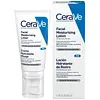What's inside
What's inside
 Key Ingredients
Key Ingredients

 Benefits
Benefits

 Concerns
Concerns

 Ingredients Side-by-side
Ingredients Side-by-side

Water
Skin ConditioningGlycerin
HumectantCaprylic/Capric Triglyceride
MaskingNiacinamide
SmoothingCetearyl Alcohol
EmollientPotassium Phosphate
BufferingCeramide NP
Skin ConditioningCeramide AP
Skin ConditioningCeramide EOP
Skin ConditioningCarbomer
Emulsion StabilisingDimethicone
EmollientCeteareth-20
CleansingBehentrimonium Methosulfate
Sodium Lauroyl Lactylate
EmulsifyingSodium Hyaluronate
HumectantCholesterol
EmollientPhenoxyethanol
PreservativeDisodium EDTA
Dipotassium Phosphate
BufferingCaprylyl Glycol
EmollientPhytosphingosine
Skin ConditioningXanthan Gum
EmulsifyingPolyglyceryl-3 Diisostearate
EmulsifyingEthylhexylglycerin
Skin ConditioningWater, Glycerin, Caprylic/Capric Triglyceride, Niacinamide, Cetearyl Alcohol, Potassium Phosphate, Ceramide NP, Ceramide AP, Ceramide EOP, Carbomer, Dimethicone, Ceteareth-20, Behentrimonium Methosulfate, Sodium Lauroyl Lactylate, Sodium Hyaluronate, Cholesterol, Phenoxyethanol, Disodium EDTA, Dipotassium Phosphate, Caprylyl Glycol, Phytosphingosine, Xanthan Gum, Polyglyceryl-3 Diisostearate, Ethylhexylglycerin
Water
Skin ConditioningCetearyl Alcohol
EmollientGlycerin
HumectantSqualane
EmollientButylene Glycol
HumectantSimmondsia Chinensis Seed Oil
EmollientSesamum Indicum Seed Oil
EmollientButyrospermum Parkii Butter
Skin ConditioningCoco-Caprylate/Caprate
EmollientSucrose Polystearate
EmollientCetyl Palmitate
EmollientUndecane
EmollientParfum
MaskingTriheptanoin
Skin Conditioning1,2-Hexanediol
Skin ConditioningTridecane
PerfumingHydroxyacetophenone
AntioxidantTocopheryl Acetate
AntioxidantXylitylglucoside
HumectantSodium Stearoyl Glutamate
CleansingAnhydroxylitol
HumectantCetearyl Glucoside
EmulsifyingXanthan Gum
EmulsifyingXylitol
HumectantSodium Polyacrylate
AbsorbentCassia Angustifolia Seed Polysaccharide
Skin ConditioningPhenoxyethanol
PreservativeAnigozanthos Flavidus Extract
Skin ConditioningDisodium EDTA
Vitis Vinifera Fruit Extract
Skin ConditioningHydroxyethylcellulose
Emulsion StabilisingDextrin
AbsorbentTheobroma Cacao Extract
Skin ConditioningMelaleuca Alternifolia Leaf Oil
AntioxidantTocopherol
AntioxidantTrehalose
HumectantLinalool
PerfumingCoumarin
PerfumingLimonene
PerfumingCitral
PerfumingGeraniol
PerfumingAmyris Balsamifera Bark Oil
MaskingJuniperus Virginiana Oil
MaskingEucalyptus Globulus Leaf Oil
PerfumingLavandula Hybrida Oil
EmollientLavandula Angustifolia Oil
MaskingCommiphora Myrrha Gum Oil
PerfumingOpoponax Oil
MaskingPogostemon Cablin Leaf Oil
MaskingRosmarinus Officinalis Leaf Oil
MaskingMentha Viridis Leaf Oil
AstringentVetiveria Zizanoides Root Oil
MaskingWater, Cetearyl Alcohol, Glycerin, Squalane, Butylene Glycol, Simmondsia Chinensis Seed Oil, Sesamum Indicum Seed Oil, Butyrospermum Parkii Butter, Coco-Caprylate/Caprate, Sucrose Polystearate, Cetyl Palmitate, Undecane, Parfum, Triheptanoin, 1,2-Hexanediol, Tridecane, Hydroxyacetophenone, Tocopheryl Acetate, Xylitylglucoside, Sodium Stearoyl Glutamate, Anhydroxylitol, Cetearyl Glucoside, Xanthan Gum, Xylitol, Sodium Polyacrylate, Cassia Angustifolia Seed Polysaccharide, Phenoxyethanol, Anigozanthos Flavidus Extract, Disodium EDTA, Vitis Vinifera Fruit Extract, Hydroxyethylcellulose, Dextrin, Theobroma Cacao Extract, Melaleuca Alternifolia Leaf Oil, Tocopherol, Trehalose, Linalool, Coumarin, Limonene, Citral, Geraniol, Amyris Balsamifera Bark Oil, Juniperus Virginiana Oil, Eucalyptus Globulus Leaf Oil, Lavandula Hybrida Oil, Lavandula Angustifolia Oil, Commiphora Myrrha Gum Oil, Opoponax Oil, Pogostemon Cablin Leaf Oil, Rosmarinus Officinalis Leaf Oil, Mentha Viridis Leaf Oil, Vetiveria Zizanoides Root Oil
 Reviews
Reviews

Ingredients Explained
These ingredients are found in both products.
Ingredients higher up in an ingredient list are typically present in a larger amount.
Cetearyl alcohol is a mixture of two fatty alcohols: cetyl alcohol and stearyl alcohol. It is mainly used as an emulsifier. Emulsifiers help prevent the separation of oils and products. Due to its composition, it can also be used to thicken a product or help create foam.
Cetearyl alcohol is an emollient. Emollients help soothe and hydrate the skin by trapping moisture.
Studies show Cetearyl alcohol is non-toxic and non-irritating. The FDA allows products labeled "alcohol-free" to have fatty alcohols.
This ingredient is usually derived from plant oils such as palm, vegetable, or coconut oils. There is debate on whether this ingredient will cause acne.
Due to the fatty acid base, this ingredient may not be Malassezia folliculitis safe.
Learn more about Cetearyl AlcoholDisodium EDTA plays a role in making products more stable by aiding other preservatives.
It is a chelating agent, meaning it neutralizes metal ions that may be found in a product.
Disodium EDTA is a salt of edetic acid and is found to be safe in cosmetic ingredients.
Learn more about Disodium EDTAGlycerin is already naturally found in your skin. It helps moisturize and protect your skin.
A study from 2016 found glycerin to be more effective as a humectant than AHAs and hyaluronic acid.
As a humectant, it helps the skin stay hydrated by pulling moisture to your skin. The low molecular weight of glycerin allows it to pull moisture into the deeper layers of your skin.
Hydrated skin improves your skin barrier; Your skin barrier helps protect against irritants and bacteria.
Glycerin has also been found to have antimicrobial and antiviral properties. Due to these properties, glycerin is often used in wound and burn treatments.
In cosmetics, glycerin is usually derived from plants such as soybean or palm. However, it can also be sourced from animals, such as tallow or animal fat.
This ingredient is organic, colorless, odorless, and non-toxic.
Glycerin is the name for this ingredient in American English. British English uses Glycerol/Glycerine.
Learn more about GlycerinPhenoxyethanol is a preservative that has germicide, antimicrobial, and aromatic properties. Studies show that phenoxyethanol can prevent microbial growth. By itself, it has a scent that is similar to that of a rose.
It's often used in formulations along with Caprylyl Glycol to preserve the shelf life of products.
Water. It's the most common cosmetic ingredient of all. You'll usually see it at the top of ingredient lists, meaning that it makes up the largest part of the product.
So why is it so popular? Water most often acts as a solvent - this means that it helps dissolve other ingredients into the formulation.
You'll also recognize water as that liquid we all need to stay alive. If you see this, drink a glass of water. Stay hydrated!
Learn more about WaterXanthan gum is used as a stabilizer and thickener within cosmetic products. It helps give products a sticky, thick feeling - preventing them from being too runny.
On the technical side of things, xanthan gum is a polysaccharide - a combination consisting of multiple sugar molecules bonded together.
Xanthan gum is a pretty common and great ingredient. It is a natural, non-toxic, non-irritating ingredient that is also commonly used in food products.
Learn more about Xanthan Gum